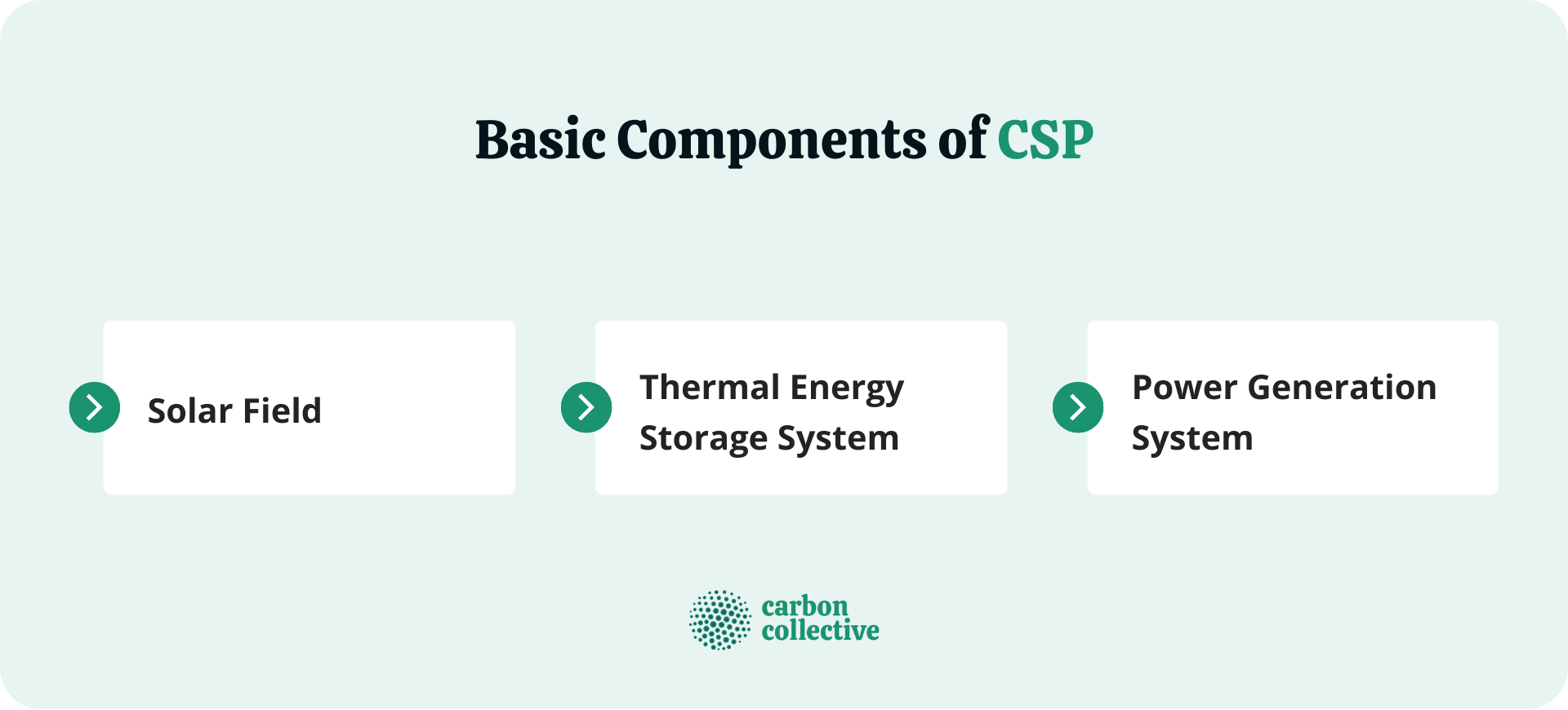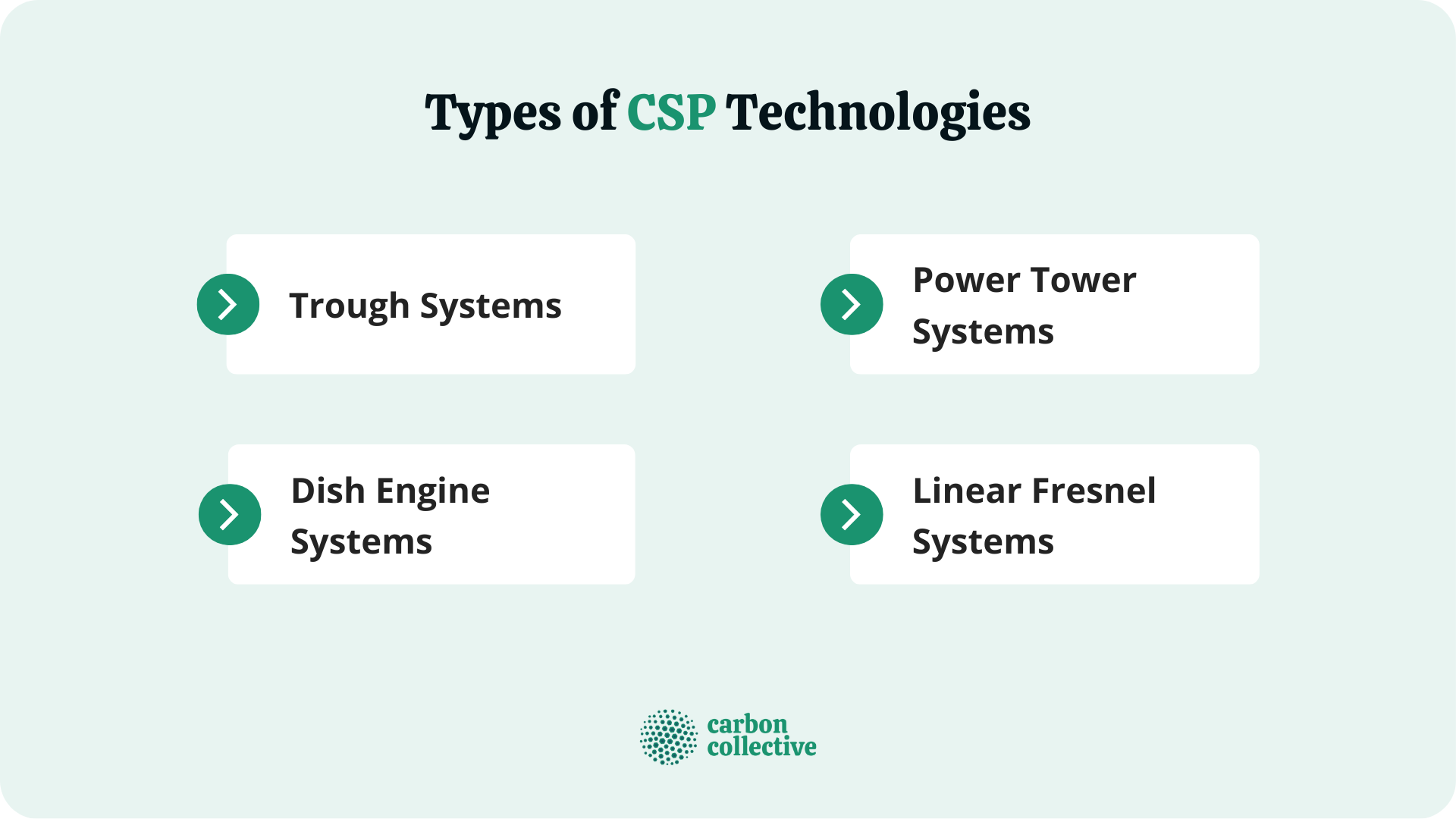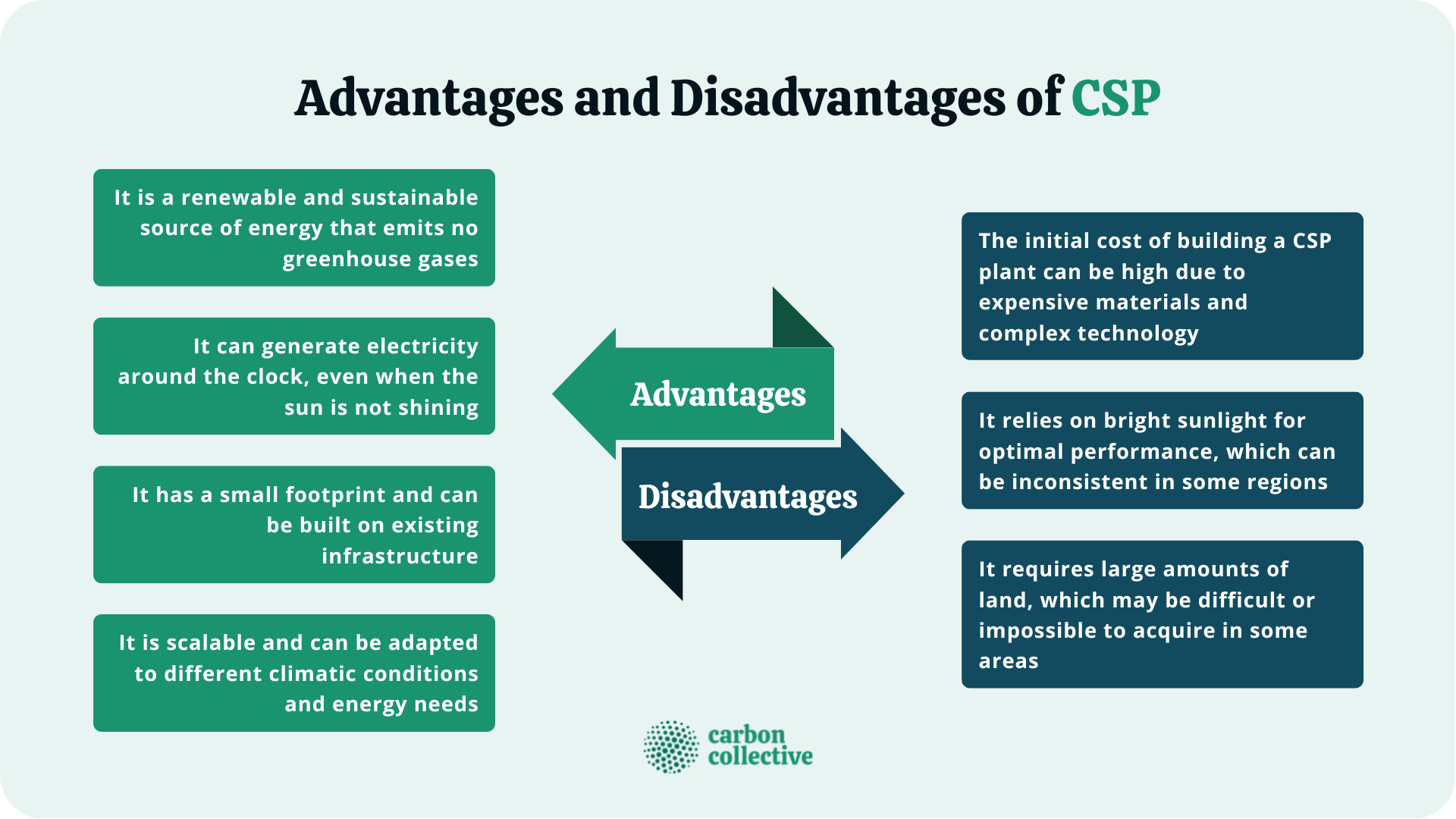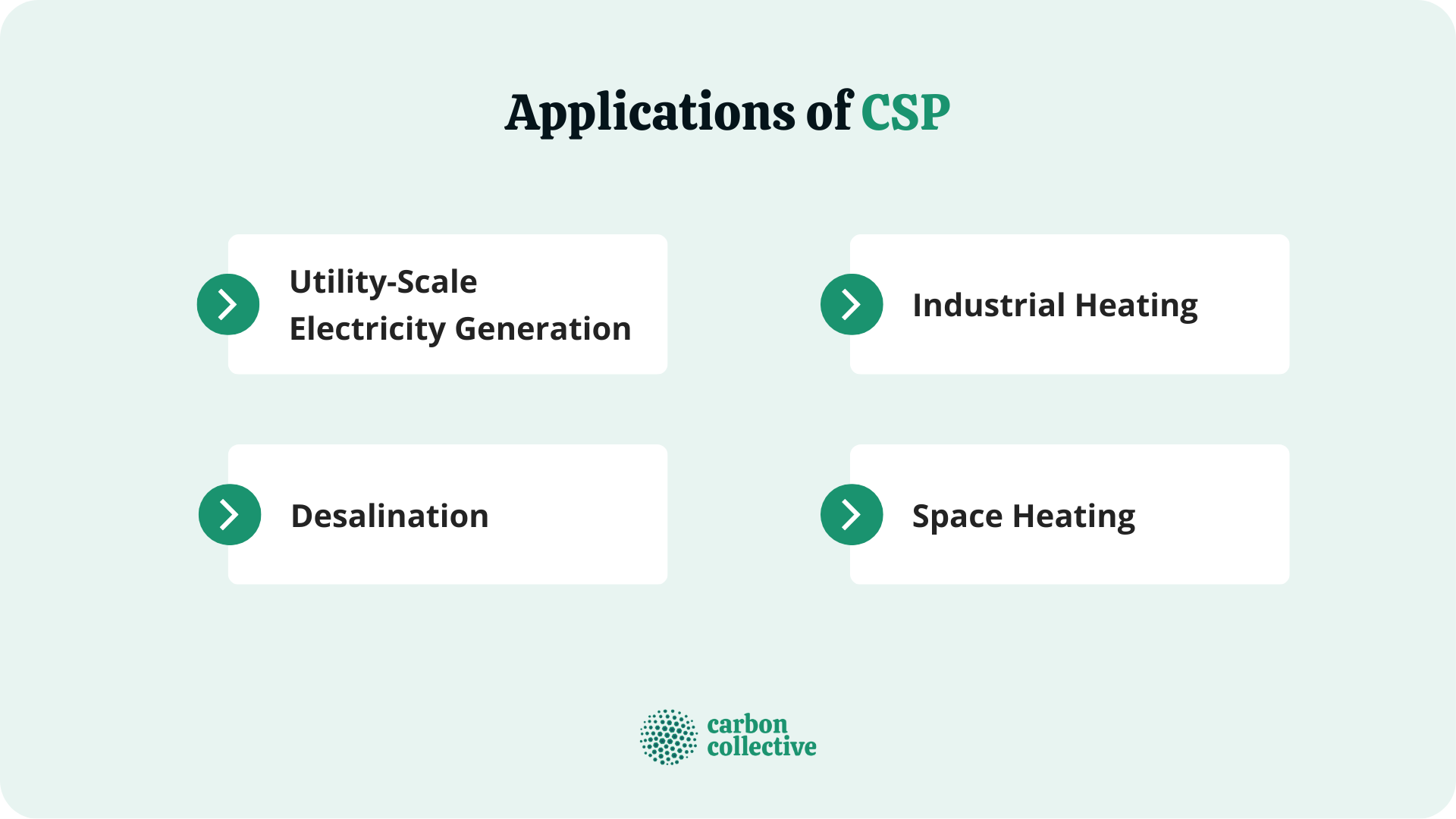Concentrating Solar Power (CSP) Defined
Concentrating Solar Power (CSP) is a rapidly growing form of solar energy that harnesses the power of the sun to generate thermal energy and electricity. It uses mirrors to concentrate and focus sunlight onto a specific area, where it is converted into heat.
CSP systems use various technologies, including parabolic troughs, solar dishes, and solar towers, to capture and concentrate sunlight onto a central receiver.
This concentrated sunlight is then used to heat a fluid that generates steam to drive a turbine generator and produce electricity.
How CSP Works
CSP uses mirrors to focus and concentrate large amounts of sunlight onto a small area.
When heat is converted from concentrated sunlight, it is generated into electricity or other applications such as water desalination and heating.
Basic Components of CSP
CSP systems are built around a few essential components: a solar field, a thermal energy storage system, and a power generation system.
Solar Field
The solar field is the area where sunlight is collected and concentrated. It comprises many mirrors, called heliostats, that track the sun and reflect its light onto a central receiver.
Thermal Energy Storage System
Thermal energy storage (TES) is a critical component of CSP systems. It allows them to store heat generated during the daytime and use it to generate electricity around the clock, even when the sun is not shining.
Power Generation System
The power generation system is the component of CSP that converts thermal energy into electricity.
This can be done using various technologies, including steam turbines, gas turbines, and Stirling engines.

Types of CSP Technologies
There are three alternative technical approaches that CSP utilizes. These are:
Trough Systems
These utilize parabolic trough collectors to concentrate sunlight onto a heat transfer fluid circulated through the receiver. The collected heat then generates steam, which can power a generator or other applications.
Dish Engine Systems
These systems use large, concave mirrors called solar dishes to concentrate sunlight onto a central receiver located at the mirror’s focal point.
The concentrated sunlight is then converted into heat, which drives a Stirling engine that generates electricity.
Power Tower Systems
Power tower systems take advantage of sun-tracking heliostats that focus sunlight onto a central receiver at the top of a tower.
The heat is then converted from the concentrated sunlight, which drives a turbine generator to produce electricity.
Linear Fresnel Systems
These systems use rows of parabolic reflectors to focus sunlight onto a liquid-filled pipe located at the focal point of each reflector.
The liquid then flows through the pipes to heat up, generating steam that powers a turbine generator.

CSP Advantages
There are many advantages to CSP, including the following:
- It is a renewable and sustainable source of energy that emits no greenhouse gases.
- It can generate electricity around the clock, even when the sun is not shining.
- It has a small footprint and can be built on existing infrastructure.
- It is scalable and can be adapted to different climatic conditions and energy needs.
CSP Disadvantages
Despite its many advantages, CSP also has some drawbacks, including:
- The initial cost of building a CSP plant can be high due to expensive materials and complex technology.
- It relies on bright sunlight for optimal performance, which can be inconsistent in some regions.
- It requires large amounts of land, which may be difficult or impossible to acquire in some areas.

Applications of CSP
CSP has a wide range of applications, including:
Utility-Scale Electricity Generation
CSP can generate clean and renewable energy for use on the grid, making it an attractive option for many utilities and power companies.
Desalination
CSP helps produce fresh water through desalination, which can benefit communities that lack access to clean drinking water.
Industrial Heating
In industries such as mining, CSP is used for thermal heat applications such as smelting, material processing, and glassmaking.
Space Heating
CSP can heat buildings and homes in colder climates, making it an efficient and environmentally-friendly alternative to traditional heating methods.

Challenges and Limitations of CSP
Despite its many advantages, CSP also faces challenges and limitations that must be addressed to be more widely adopted. These include:
The high cost of building and maintaining a CSP plant can make competing with traditional energy sources complex.
CSP relies heavily on bright sunlight, leading to fluctuations in output in some regions.
The land requirements for CSP can be significant, which may limit its implementation in some areas.
Recent Developments in CSP Technology
Despite these challenges, CSP technology has continued to evolve and develop in recent years. Newer versions of CSP plants are now being built that are more efficient and have lower costs.
In addition, new storage methods are being developed to help address fluctuations in output.
With continued advancements in CSP technology, it is hoped that these challenges can be overcome and that CSP will become a more widely used renewable energy source in the future.
FAQs
1) What is Concentrating Solar Power (CSP)?
Concentrating Solar Power, or CSP, refers to various technologies that use concentrated sunlight to generate heat and, in turn, electricity.
2) How does CSP work?
CSP systems use rows of parabolic reflectors to focus sunlight onto a liquid-filled pipe located at the focal point of each reflector. The liquid then flows through the pipes to heat up, which is used to generate steam that powers a turbine generator.
3) What are the advantages of CSP?
CSP has many advantages, including that it is a renewable and sustainable source of energy that emits no greenhouse gases. Additionally, CSP generates electricity around the clock, even when the sun is not shining.
4) What are the challenges or limitations of CSP?
One challenge facing CSP is that the initial cost of building a CSP plant can be high due to expensive materials and complex technology. In addition, CSP is heavily reliant on bright sunlight, leading to fluctuations in output in some regions.
5) What are some of the main applications of CSP?
CSP’s primary applications include utility-scale electricity generation, desalination to produce freshwater, industrial heating, and space heating in colder climates.

Written by Zach Stein



